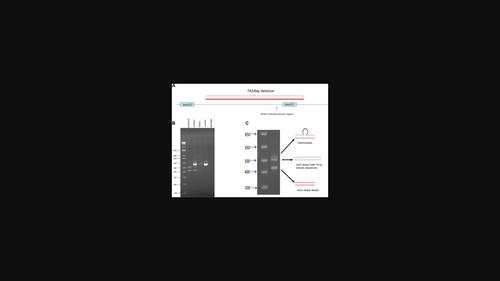当前位置:
X-MOL 学术
›
Hum. Mutat.
›
论文详情
Our official English website, www.x-mol.net, welcomes your feedback! (Note: you will need to create a separate account there.)
A recurrent single-exon deletion in TBCK might be under-recognized in patients with infantile hypotonia and psychomotor delay
Human Mutation ( IF 3.9 ) Pub Date : 2022-11-01 , DOI: 10.1002/humu.24497 Hongzheng Dai 1, 2 , Wenmiao Zhu 2 , Bo Yuan 1, 2, 3 , Nicole Walley 4 , Kelly Schoch 4 , Yong-Hui Jiang 4 , John A Phillips 5 , Melissa S Jones 6 , Pengfei Liu 1, 2 , David R Murdock 1 , Lindsay C Burrage 1, 7 , Brendan Lee 1 , Jill A Rosenfeld 1 , Rui Xiao 1, 2 ,
Human Mutation ( IF 3.9 ) Pub Date : 2022-11-01 , DOI: 10.1002/humu.24497 Hongzheng Dai 1, 2 , Wenmiao Zhu 2 , Bo Yuan 1, 2, 3 , Nicole Walley 4 , Kelly Schoch 4 , Yong-Hui Jiang 4 , John A Phillips 5 , Melissa S Jones 6 , Pengfei Liu 1, 2 , David R Murdock 1 , Lindsay C Burrage 1, 7 , Brendan Lee 1 , Jill A Rosenfeld 1 , Rui Xiao 1, 2 ,
Affiliation

|
Advanced bioinformatics algorithms allow detection of multiple-exon copy-number variations (CNVs) from exome sequencing (ES) data, while detection of single-exon CNVs remains challenging. A retrospective review of Baylor Genetics' clinical ES patient cohort identified four individuals with homozygous single-exon deletions of TBCK (exon 23, NM_001163435.2), a gene associated with an autosomal recessive neurodevelopmental phenotype. To evaluate the prevalence of this deletion and its contribution to disease, we retrospectively analyzed single nucleotide polymorphism (SNP) array data for 8194 individuals undergoing ES, followed by PCR confirmation and RT-PCR on individuals carrying homozygous or heterozygous exon 23 TBCK deletions. A fifth individual was diagnosed with the TBCK-related disorder due to a heterozygous exon 23 deletion in trans with a c.1860+1G>A (NM_001163435.2) pathogenic variant, and three additional heterozygous carriers were identified. Affected individuals and carriers were from diverse ethnicities including European Caucasian, South Asian, Middle Eastern, Hispanic American and African American, with only one family reporting consanguinity. RT-PCR revealed two out-of-frame transcripts related to the exon 23 deletion. Our results highlight the importance of identifying single-exon deletions in clinical ES, especially for genes carrying recurrent deletions. For patients with early-onset hypotonia and psychomotor delay, this single-exon TBCK deletion might be under-recognized due to technical limitations of ES.
中文翻译:

TBCK 复发性单外显子缺失在婴儿肌张力减退和精神运动迟缓患者中可能未被充分认识
先进的生物信息学算法允许从外显子组测序 (ES) 数据中检测多外显子拷贝数变异 (CNV),而检测单外显子 CNV 仍然具有挑战性。对 Baylor Genetics 的临床 ES 患者队列的回顾性研究确定了 4 个具有TBCK(外显子 23,NM_001163435.2)纯合单外显子缺失的个体,该基因与常染色体隐性神经发育表型相关。为了评估这种缺失的普遍性及其对疾病的影响,我们回顾性分析了 8194 名接受 ES 治疗的个体的单核苷酸多态性 (SNP) 阵列数据,然后对携带纯合或杂合外显子 23 TBCK缺失的个体进行 PCR 确认和 RT-PCR。第五个人被诊断出患有TBCK相关疾病是由于 23 号外显子杂合缺失引起的反式突变,具有 c.1860+1G>A (NM_001163435.2) 致病性变异,并鉴定出另外三个杂合子携带者。受影响的个人和携带者来自不同种族,包括欧洲高加索人、南亚人、中东人、西班牙裔美国人和非裔美国人,只有一个家庭报告有血缘关系。RT-PCR 揭示了两个与外显子 23 缺失相关的框外转录本。我们的结果强调了识别临床 ES 中单外显子缺失的重要性,尤其是对于携带反复缺失的基因。对于早发性肌张力减退和精神运动迟缓的患者,由于 ES 的技术限制,这种单外显子TBCK缺失可能未被充分认识。
更新日期:2022-11-01
中文翻译:

TBCK 复发性单外显子缺失在婴儿肌张力减退和精神运动迟缓患者中可能未被充分认识
先进的生物信息学算法允许从外显子组测序 (ES) 数据中检测多外显子拷贝数变异 (CNV),而检测单外显子 CNV 仍然具有挑战性。对 Baylor Genetics 的临床 ES 患者队列的回顾性研究确定了 4 个具有TBCK(外显子 23,NM_001163435.2)纯合单外显子缺失的个体,该基因与常染色体隐性神经发育表型相关。为了评估这种缺失的普遍性及其对疾病的影响,我们回顾性分析了 8194 名接受 ES 治疗的个体的单核苷酸多态性 (SNP) 阵列数据,然后对携带纯合或杂合外显子 23 TBCK缺失的个体进行 PCR 确认和 RT-PCR。第五个人被诊断出患有TBCK相关疾病是由于 23 号外显子杂合缺失引起的反式突变,具有 c.1860+1G>A (NM_001163435.2) 致病性变异,并鉴定出另外三个杂合子携带者。受影响的个人和携带者来自不同种族,包括欧洲高加索人、南亚人、中东人、西班牙裔美国人和非裔美国人,只有一个家庭报告有血缘关系。RT-PCR 揭示了两个与外显子 23 缺失相关的框外转录本。我们的结果强调了识别临床 ES 中单外显子缺失的重要性,尤其是对于携带反复缺失的基因。对于早发性肌张力减退和精神运动迟缓的患者,由于 ES 的技术限制,这种单外显子TBCK缺失可能未被充分认识。



























 京公网安备 11010802027423号
京公网安备 11010802027423号